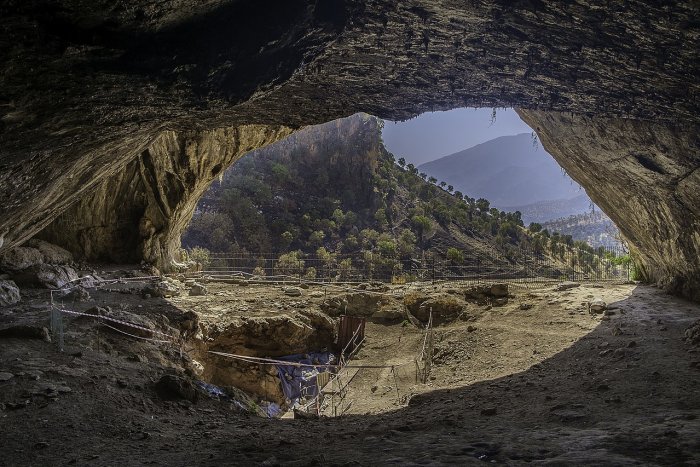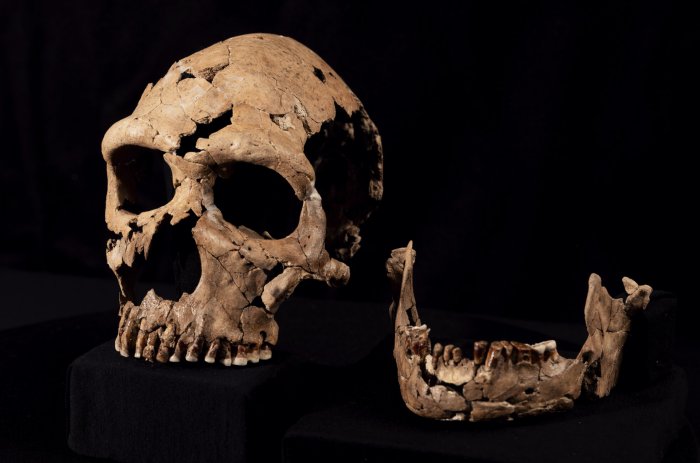Facial Reconstruction Of A 75,000-Year-Old Neanderthal Woman From Shanidar Cave

Jan Bartek – AncientPages.com – Facial reconstruction is a meticulous and time-intensive process that allows us to visualize the appearance of individuals from the past. This technique involves carefully analyzing and interpreting skeletal remains to recreate the facial features and overall physiognomy. While intriguing, it requires a high level of expertise and attention to detail to accurately depict the facial characteristics of those who lived long ago.
Inside the Shanidar Cave. Credit: Hardscarf – CC BY-SA 4.0
A groundbreaking Netflix documentary has unveiled the reconstructed face of a 75,000-year-old female Neanderthal, shedding light on our ancient ancestors. The remarkable feat was accomplished by a team of archaeologists and conservators led by the University of Cambridge, who meticulously rebuilt the flattened skull from hundreds of bone fragments discovered in 2018.
The excavation site, Shanidar Cave in Iraqi Kurdistan, holds significant historical value as a recurring burial ground for Neanderthals. This cave gained prominence in the late 1950s when several Neanderthal remains were unearthed. Last year scientists re-examined Neanderthals’ perplexing Flower Burial at Shanidar Cave and made a fascinating discovery. Based on the discovered evidence Neanderthals buried their dead and conducted funerary rites with flowers.
The new documentary “Secrets of the Neanderthals,” produced by BBC Studios Science Unit, has been released worldwide on Netflix. This informative film provides viewers with an opportunity to follow the team led by researchers from the University of Cambridge and Liverpool John Moores University as they embark on a journey back to Shanidar Cave to continue their excavations.
The documentary promises to shed light on the intriguing world of our ancient Neanderthal ancestors, offering insights into their lives and behaviors through the exploration of this significant archaeological site.
The skull of Shanidar Z, which has been reconstructed in the lab at the University of Cambridge. Credit: BBC Studios/Jamie Simonds
“The skulls of Neanderthals and humans look very different,” said Dr. Emma Pomeroy, a paleo-anthropologist from Cambridge’s Department of Archaeology, who features in the new film.
“Neanderthal skulls have huge brow ridges and lack chins, with a projecting midface that results in more prominent noses. But the recreated face suggests those differences were not so stark in life.
“It’s perhaps easier to see how interbreeding occurred between our species, to the extent that almost everyone alive today still has Neanderthal DNA.”
Neanderthals, an extinct species of humans, are believed to have disappeared approximately 40,000 years ago. Discoveries of their remains have been scarce, making each new find a significant event. The Neanderthal featured in the documentary is the first to be uncovered from the cave in over five decades, and potentially the most well-preserved individual specimen found in this century.
The skull of Shanidar Z, which has been reconstructed in the lab at the University of Cambridge. Credit: BBC Studios/Jamie Simonds
Previous Neanderthal discoveries were assigned numerical designations, but this particular specimen is referred to as Shanidar Z. Researchers speculate that it may be the upper portion of an individual excavated in 1960, providing a unique opportunity to study and analyze this ancient human species further.
The examined Neanderthal skull in question underwent significant deformation due to specific circumstances. Initially, the head was crushed, likely by a rockfall incident, shortly after the individual’s demise. This occurred during the transitional period when the brain had decomposed, but before the cranial cavity became filled with dirt. Subsequently, the compression intensified over tens of thousands of years as sediment accumulated, further compacting the skull. Consequently, when archaeologists discovered the remains, the skull had been flattened to a mere two centimeters in thickness.
The excavation team carefully uncovered the remains, revealing an articulated skeleton extending almost to the waist. They employed a consolidant, a glue-like substance, to reinforce the bones and surrounding sediment, ensuring their structural integrity. The process involved extracting Shanidar Z in numerous small foil-wrapped blocks from beneath seven and a half meters of soil and rock within the cave’s interior. This methodical approach aimed to preserve the delicate archaeological evidence for further analysis and study.
In the Cambridge lab, researchers employed micro-CT scans to capture detailed images of each block before methodically diluting the glue. These scans served as a guide for the extraction of bone fragments. Dr. Lucía López-Polín, the lead conservator, pieced together over 200 fragments of the skull freehand, reconstructing its original shape, including the upper and lower jaws. This painstaking process allowed for the restoration of the skull to its original form.
“Each skull fragment is gently cleaned while glue and consolidant are re-added to stabilize the bone, which can be very soft, similar in consistency to a biscuit dunked in tea,” said Pomeroy. “It’s like a high stakes 3D jigsaw puzzle. A single block can take over a fortnight to process.”
The reconstructed skull underwent a surface scan and 3D printing process, serving as the foundation for a recreated head. This intricate task was undertaken by renowned paleoartists and identical twins Adrie and Alfons Kennis, who built up layers of fabricated muscle and skin to unveil a facial reconstruction. New analysis indicates that Shanidar Z was likely an older female, potentially in her mid-forties, according to researchers – a remarkable age to attain during that era of prehistory.
The determination of the sex and age of the Neanderthal individual, known as Shanidar Z, relied on innovative techniques due to the absence of pelvic bones. Sequencing of tooth enamel proteins provided insights into her sex, while the levels of wear and tear on her teeth, with some front teeth worn down to the root, were used to estimate her age. Standing at around five feet tall, with some of the smallest adult arm bones in the Neanderthal fossil record, her physique further supported the identification as a female.
Notably, Shanidar Z is the fifth Neanderthal individual to be found in a cluster of bodies buried at a similar time in the same location within the cave. This cluster is situated behind a massive vertical rock, over two meters tall at the time, which stands prominently in the center of the cave. To date, remnants of at least ten separate Neanderthals have been discovered in this remarkable cave site.
The rock formation found in the burial site predates the interment of the human remains. According to researchers, this rock had fallen from the cave ceiling long before the bodies were placed there. They suggest that the prominent rock may have served as a landmark for Neanderthals, enabling them to identify and repeatedly use this specific location for burial purposes.
The recreated head of Shanidar Z, made by the Kennis brothers for the Netflix documentary ‘Secrets of the Neanderthals’ based on 3D scans of the reconstructed skull. Credit: BBC Studios/Jamie Simonds
“Neanderthals have had a bad press ever since the first ones were found over 150 years ago,” said Professor Graeme Barker from Cambridge’s McDonald Institute for Archaeological Research, who leads the excavations at the cave.
“Our discoveries show that the Shanidar Neanderthals may have been thinking about death and its aftermath in ways not so very different from their closest evolutionary cousins—ourselves.”
“Shanidar Cave was used first by Neanderthals and then by our own species, so it provides an ideal laboratory to tackle one of the biggest questions of human evolution,” said Barker in a press release.
See also: More Archaeology News
“Why did Neanderthals disappear from the stage around the same time as Homo sapiens spread over regions where Neanderthals had lived successfully for almost half a million years?”
While many unanswered questions remain about this extinct human species, the evidence uncovered through excavations and research has proven that Neanderthals were not the primitive creatures they were once assumed to be. These findings have provided valuable insights into their advanced capabilities and complex behaviors, challenging long-held misconceptions and expanding our understanding of human evolution.
Written by Jan Bartek – AncientPages.com Staff Writer








